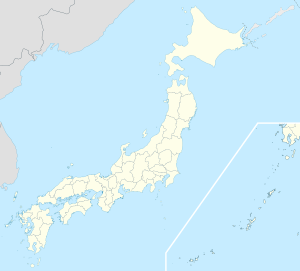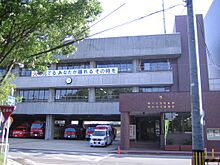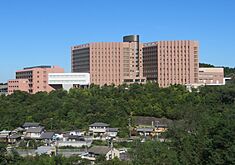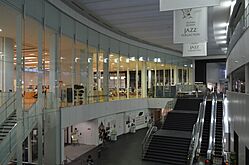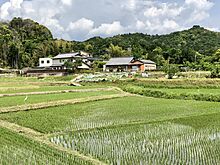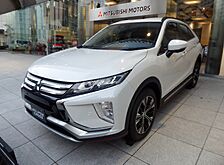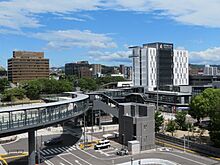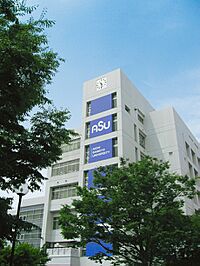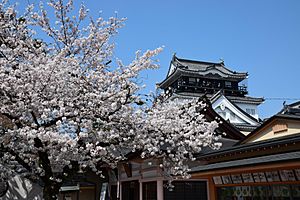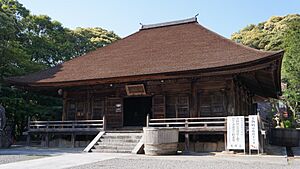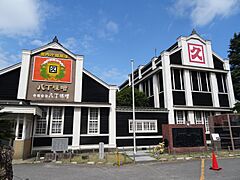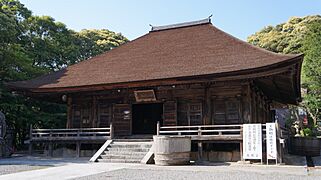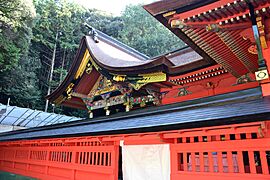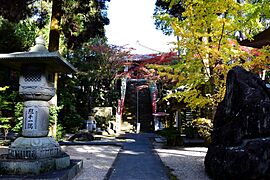Okazaki, Aichi facts for kids
Quick facts for kids
Okazaki
岡崎市
|
|||||||||||||
|---|---|---|---|---|---|---|---|---|---|---|---|---|---|
|
|
|||||||||||||
|
|||||||||||||
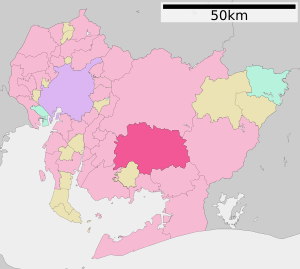
Location of Okazaki in Aichi Prefecture
|
|||||||||||||
| Country | Japan | ||||||||||||
| Region | Chūbu (Tōkai) | ||||||||||||
| Prefecture | Aichi | ||||||||||||
| First official recorded | 315 AD | ||||||||||||
| City Settled | June 1, 1916 | ||||||||||||
| Area | |||||||||||||
| • Total | 387.20 km2 (149.50 sq mi) | ||||||||||||
| Population
(October 1, 2019)
|
|||||||||||||
| • Total | 386,999 | ||||||||||||
| • Density | 999.481/km2 (2,588.64/sq mi) | ||||||||||||
| Time zone | UTC+9 (Japan Standard Time) | ||||||||||||
| Phone number | 0564-23-6495 | ||||||||||||
| Address | 2–9 Jūō-chō, Okazaki-shi, Aichi-ken 444-8601 | ||||||||||||
| Climate | Cfa | ||||||||||||
|
|||||||||||||
Okazaki (岡崎市, Okazaki-shi) is a city located in Aichi Prefecture, Japan. As of October 2019, about 387,000 people lived there in 164,087 homes. The city covers an area of about 387 square kilometers.
Contents
Geography and Climate
Okazaki is in the flat coastal areas of southeastern Aichi Prefecture. The land gently rises into rolling hills in the northeast. About 60% of the city is covered by forests, so these areas are not very crowded.
Okazaki is about 400 kilometers (250 miles) southwest of Tokyo.
Okazaki's Climate
The city has a climate with hot, humid summers and mild winters. The average yearly temperature in Okazaki is about 15.5 degrees Celsius (60 degrees Fahrenheit). The city gets about 1507.6 millimeters (59 inches) of rain each year. September is usually the wettest month.
Temperatures are highest in August, averaging around 27.4 degrees Celsius (81 degrees Fahrenheit). The coldest month is January, with temperatures around 4.1 degrees Celsius (39 degrees Fahrenheit).
| Climate data for Okazaki (1991−2020 normals, extremes 1979−present) | |||||||||||||
|---|---|---|---|---|---|---|---|---|---|---|---|---|---|
| Month | Jan | Feb | Mar | Apr | May | Jun | Jul | Aug | Sep | Oct | Nov | Dec | Year |
| Record high °C (°F) | 17.2 (63.0) |
21.6 (70.9) |
24.6 (76.3) |
29.5 (85.1) |
32.8 (91.0) |
36.1 (97.0) |
39.3 (102.7) |
39.0 (102.2) |
37.8 (100.0) |
31.9 (89.4) |
26.1 (79.0) |
23.1 (73.6) |
39.3 (102.7) |
| Mean daily maximum °C (°F) | 9.1 (48.4) |
10.2 (50.4) |
14.1 (57.4) |
19.6 (67.3) |
24.2 (75.6) |
27.1 (80.8) |
31.0 (87.8) |
32.7 (90.9) |
29.0 (84.2) |
23.3 (73.9) |
17.4 (63.3) |
11.6 (52.9) |
20.8 (69.4) |
| Daily mean °C (°F) | 4.1 (39.4) |
5.0 (41.0) |
8.6 (47.5) |
13.8 (56.8) |
18.6 (65.5) |
22.3 (72.1) |
26.2 (79.2) |
27.4 (81.3) |
23.9 (75.0) |
17.9 (64.2) |
11.8 (53.2) |
6.4 (43.5) |
15.5 (59.9) |
| Mean daily minimum °C (°F) | −0.7 (30.7) |
0.0 (32.0) |
3.1 (37.6) |
8.1 (46.6) |
13.3 (55.9) |
18.2 (64.8) |
22.5 (72.5) |
23.3 (73.9) |
19.7 (67.5) |
13.2 (55.8) |
6.5 (43.7) |
1.4 (34.5) |
10.7 (51.3) |
| Record low °C (°F) | −7.6 (18.3) |
−7.6 (18.3) |
−4.7 (23.5) |
−1.9 (28.6) |
3.1 (37.6) |
8.9 (48.0) |
15.1 (59.2) |
14.8 (58.6) |
7.8 (46.0) |
2.3 (36.1) |
−1.7 (28.9) |
−6.5 (20.3) |
−7.6 (18.3) |
| Average precipitation mm (inches) | 53.7 (2.11) |
60.9 (2.40) |
115.8 (4.56) |
123.6 (4.87) |
139.4 (5.49) |
177.1 (6.97) |
184.1 (7.25) |
117.9 (4.64) |
223.5 (8.80) |
177.1 (6.97) |
80.2 (3.16) |
57.2 (2.25) |
1,507.6 (59.35) |
| Average precipitation days (≥ 1.0 mm) | 5.4 | 6.3 | 9.2 | 9.4 | 9.7 | 12.0 | 11.0 | 7.7 | 10.6 | 9.9 | 6.6 | 6.1 | 103.9 |
| Mean monthly sunshine hours | 172.0 | 165.5 | 191.5 | 193.5 | 194.2 | 136.7 | 164.8 | 210.8 | 159.6 | 162.2 | 162.8 | 167.4 | 2,081 |
| Source: Japan Meteorological Agency | |||||||||||||
Okazaki's Population Growth
The number of people living in Okazaki has steadily grown over the last 60 years. This growth is partly because there are many jobs and affordable homes near Nagoya.
In November 2019, about 12,581 foreign nationals lived in Okazaki. This is about 2.92% of the total population. Over half of these foreign residents are from Brazil. Other large groups include people from Korea, China, and the Philippines.
| Historical population | ||
|---|---|---|
| Year | Pop. | ±% |
| 1960 | 186,559 | — |
| 1970 | 219,092 | +17.4% |
| 1980 | 271,243 | +23.8% |
| 1990 | 316,334 | +16.6% |
| 2000 | 345,997 | +9.4% |
| 2010 | 373,472 | +7.9% |
Neighboring Cities and Towns
Okazaki shares its borders with several other places in Aichi Prefecture:
- Toyokawa
- Shinshiro
- Toyota
- Nishio
- Kōta
- Anjō
- Gamagōri
City Views
Okazaki's History
Early Beginnings
People have lived in the Okazaki area for thousands of years. Archaeologists have found tools and remains from the Japanese Paleolithic period. Many ancient burial mounds, called kofun, have also been found from the Jōmon period, Yayoi, and Kofun periods.
Feudal Japan Era
During the Sengoku period (a time of many wars), the Matsudaira clan controlled this area. A part of this clan later became the powerful Tokugawa clan, who ruled Japan for a long time during the Edo period.
In the Edo period, Okazaki became an important han (feudal domain) with its own castle. The town grew as a busy post station on the Tōkaidō road, which connected the old capital Kyoto with Edo (modern-day Tokyo).
Modern Okazaki Takes Shape
After the Meiji Restoration in 1868, the modern town of Okazaki was officially created on October 1, 1889. It grew by joining with nearby towns like Hirohata in 1914. Okazaki officially became a city on July 1, 1916.
The city faced challenges from natural disasters. It was damaged by earthquakes in 1944 and 1945. During World War II, a bombing raid on July 19, 1945, destroyed much of the city center and caused many deaths.
Okazaki Today
In 1955, Okazaki grew much larger by merging with several surrounding towns and villages. In 1959, Typhoon Vera caused significant damage and took the lives of 27 residents.
On April 1, 2003, Okazaki was named a core city. This gave it more independence from the prefectural government. In 2006, the town of Nukata also merged into Okazaki.
Public Services
Okazaki has its own police and fire departments to keep everyone safe. It also has a main post office and the Okazaki City Library, which is a great place for reading and learning.
Sister Cities
Okazaki has special friendships with cities around the world:
 Newport Beach, California, United States (since 1984)
Newport Beach, California, United States (since 1984) Uddevalla, Sweden (since 1968)
Uddevalla, Sweden (since 1968) Hohhot, Inner Mongolia, China (since 1987)
Hohhot, Inner Mongolia, China (since 1987)
Okazaki's Economy


In the past, Okazaki was known for making textiles (fabrics) and miso (a traditional Japanese paste). Today, it's a center for chemical and machinery industries.
Main Industries
- Agriculture: Farmers grow crops like Konjac, Tea, and ingredients for Miso.
- Forestry: The city has forests with trees like Cryptomeria and Chamaecyparis obtusa.
- Manufacturing: Okazaki is famous for making stone tōrō (Japanese lanterns). This traditional stonemasonry is a recognized Japanese craft. Mitsubishi Motors also has a factory here.
- Shopping: There are many shopping centers like Æon Mall Okazaki and Wing Town.
-
Paddy field in Iwanaka Town
Education in Okazaki
Okazaki has many schools for students of all ages.
Universities and Colleges
- National Institutes of Natural Sciences
- National Institute for Physiological Sciences
- National Institute for Basic Biology
- Aichi Gakusen University
- Aichi Gakusen College
- Aichi Sangyo University
- University of Human Environments
- Okazaki Women's Junior College
- Yamasa Institute
Schools for Younger Students
The city government runs 48 public elementary schools and 21 public junior high schools. There is also one private middle school. For older students, there are seven public high schools and four private high schools, including the Hikarigaoka Girls' High School. There are also special education schools for students with disabilities.
Transportation
Train Travel
Okazaki is connected by several train lines. The Tōkaidō Shinkansen (bullet train) passes through the city, but it doesn't stop here. You can catch the Shinkansen at nearby stations like Toyohashi or Mikawa-Anjō.
Local train lines include:
- JR Central Tōkaidō Main Line: Okazaki Station, Nishi-Okazaki Station
- Meitetsu Nagoya Line: Motojuku, Meiden-Yamanaka, Fujikawa, Miai, Otogawa, Higashi-Okazaki, Okazakikōen-mae, Yahagibashi, Utō
- Aichi Loop Line Co Ltd: Okazaki, Mutsuna, Naka-Okazaki, Kita-Okazaki, Daimon, Kitano-Masuzuka
Roads and Highways
Major highways run through Okazaki, making it easy to travel by car. These include:
- Tōmei Expressway (part of the Asian Highway Network)
- Shin-Tōmei Expressway
Important national routes that pass through the city are:
- Japan National Route 1
- Japan National Route 248
- Japan National Route 301
- Japan National Route 473
Local Attractions and Fun Things to Do
Okazaki Castle
Okazaki Castle was first built in 1455. It became famous because Tokugawa Ieyasu, a very important historical figure who unified Japan, was born there. Even though he moved away later, the castle is still strongly linked to him. During the Edo period, it was the main castle for the Okazaki area.
Amazing Fireworks
Okazaki is well-known for its incredible fireworks! Long ago, the government limited where gunpowder could be made, and Okazaki was one of the few places allowed to make it. Even today, over 70% of Japan's fireworks are designed and made here.
Every year, on the first Saturday of August, a huge fireworks festival takes place near Okazaki Castle. People from all over Japan come to see this spectacular show!
Delicious Hatchō Miso

Hatchō miso (八丁味噌) is a special dark miso paste. It's made by steaming soybeans and then letting them age in large cedar barrels for at least two years. Heavy river stones weighing 3 tons are carefully stacked on top of the barrels to help the process.
There are two main Hatchō miso companies located about 900 meters (8 chō) west of Okazaki Castle. One of them, Kakukyu, has been a family business for 18 generations! Their old buildings are even protected as historical sites. Hatchō miso is very famous in Japan and is known for being a healthy food. You can take free tours and try samples!
Takisan Temple and Shrine
The Buddhist temple of Takisan-ji was built in the 7th century. It has several important cultural treasures. Its main hall, built during the Kamakura period, hosts a special fire festival every February. The unique Sanmon gate and the main statue are also important cultural properties.
Next to the temple is Takisan Tōshō-gū, a Shinto Shrine built in 1646 by Tokugawa Iemitsu.
Culture and Language
The local language spoken in Okazaki is called the Mikawa dialect. While it's very similar to standard Japanese, it has some small, unique differences. It's quite different from the Nagoya dialect spoken in western Aichi. Over the years, with more people moving to Okazaki and the influence of TV and media, many people now use standard Japanese in their daily lives.
Notable People from Okazaki
Many talented people come from Okazaki, including:
- Takako Okamura, a singer-songwriter
- Yuki Fukaya, a professional men’s soccer player
- Naoko Fukazu, a professional women's table tennis player
- Sei Hiraizumi, an actor
- Kotaro Honda, a scientist who studied metals
- Yuko Kawai, a pianist
- Motoo Kimura, a biologist
- Takashi Kondō, a voice actor
- Takeshi Nagata, a geophysicist
- Immi, a musician
- Kotomitsuki Keiji, a sumo wrestler
- Ryo Miyaichi, a professional men’s soccer player
- Daisuke Nakajima, a race car driver
- Satoru Nakajima, a race car driver
- Kazuki Nakajima, a race car driver
- Masamitsu Naito, a politician
- Hitoshi Ogawa, a race car driver
- Takahiro Sakurai, a voice actor
- Yasuo Segawa, an illustrator
- Shiga Shigetaka, a geographer
- Seiken Sugiura, a politician
- Yumiko Tsuzuki, a professional women's volleyball player
- Hiromasa Yamamoto, a professional men’s soccer player
- Yūki Ishikawa, a professional men's volleyball player
- Yasunobu Okada, a professor at the National Institute for Physiological Sciences (NIPS).
See also
 In Spanish: Okazaki (Aichi) para niños
In Spanish: Okazaki (Aichi) para niños









